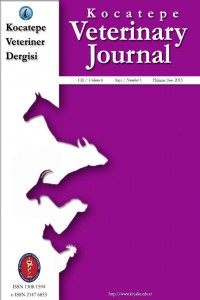Abstract
One of the main problems of poultry industry is recycling the wastes in an environment friendly and sustainable way. Some processing ways of poultry manure are anaerobic processing, aerobic processing, dehydration and incineration. Best management practices for safe and beneficial utilization of poultry manure with minimum impact on environment, it should be handled properly. Conversion to energy, fertilizer or feedstuff for animals is main uses of poultry litter. The system selected for recycling should be based on economics, engineering, public reaction and regulation as well as factors related to agriculture
Keywords
References
- Adeniran KA, Ahaneku IE, Itodo IN, Rohjy HA. 20 Relative Effectiveness of Biogas Production using Poultry Wastes and Cow Dung. Indian Journal of Energy 1 (5): 56-62. Anonymous. 1990. A Review of Poultry Manure Management: Directions for the Future. Agriculture and Agri-Food Canada, Poultry Section.
- Arthur R, Baidoo MF, Antwi E. 2011. Biogas as a potential renewable energy source: A Ghanaian case study. Renewable Energy 36: 1510-1516.
- Bolan NS, Szogi AA, Chuasavathi T, Seshadri B, Rothrock MJ, Panneerselvam P. 2010. Uses and management of poultry litter. World's Poultry Science Journal, 66: 673-698.
- Bowen B, Lynch B, Lynch D, Henihan AM, Leahy JJ, McDonnel K. 2010. Biosecurity on Poultry Farms from On-Farm Fluidized Bed Combustion and Energy Recovery from Poultry Litter. Sustainability, 2: 2135-2143.
- FAO. 2008. Poultry production and the environment – a review, by P. Gerber, C. Opio & H. Steinfeld. In O. Thieme & D. Pilling, eds. Proceedings of the International Conference Poultry in the Twenty-first Century: avian influenza and beyond, held 5–7 November 2007, Bangkok, Thailand. Rome.
- Jensen KL, Roberts RK, Bazen E, Menard RJ, English BC. 2010. Farmer Willingness to Supply Poultry Litter for Energy Conversion and to Invest in an Energy Conversion Cooperative. Journal of Agricultural and Applied Economics, 42 (1): 105–119.
- Kelleher BP, Leahy JJ, Henihan AM, O’Dwyer TF, Sutton D, Leahy MJ. 2002. Advances in poultry litter disposal technology – a review. Bioresource Technology 83: 27–36.
- Kvasauskas M, Baltrėnas P. 2009. Research on anaerobically treated organic waste suitability for soil fertilization. J. Environ. Eng. Land Manag, 17 (4):205-211.
- Mitchell CC, Donald JO. 1999. The Value and Use of Poultry Manures as Fertilizer. Alabama Cooperative Extension System, ANR 244.
- Ogejo JA, Eldridge R, Collins Jr. 2009. Storing and Handling Poultry Litter. College of Agriculture and Life Sciences, Virginia Polytechnic Institute and State University, Publication 442-054.
- Taleghani GS, Kia A. 2005. Technical-economical analysis of the Saveh biogas power plant. Renewable Energy, 30(3):441-446.
Abstract
Kanatlı sektörünün ana problemlerinden birisi, atıkların çevreye yararlı ve sürdürülebilir şekilde geri dönüştürülmesidir. Kanatlı gübresini işlemenin bazı yolları arasında aerobik, anaerobik işlemler, dehidrasyon ve yakma sayılabilir. Gübrenin değerlendirilmesinde çevreye minimum düzeyde etkisinin olması ve hem güvenli hem de kazançlı kullanılabilmesi için doğru şekilde idare edilmesi gerekmektedir. Kanatlı gübresinin bazı kullanım alanları arasında enerjiye dönüştürülmesi, tarımda gübre olarak kullanılması veya yem olarak değerlendirilmesi sayılabilir. Geri dönüşüm için tercih edilen sistemin ekonomi, mühendislik, kamuoyu tepkisi, yasal dayanaklar ve tarım ve hayvancılıkla ilgili faktörler temelinde oluşturulması gerekmektedir.
Keywords
References
- Adeniran KA, Ahaneku IE, Itodo IN, Rohjy HA. 20 Relative Effectiveness of Biogas Production using Poultry Wastes and Cow Dung. Indian Journal of Energy 1 (5): 56-62. Anonymous. 1990. A Review of Poultry Manure Management: Directions for the Future. Agriculture and Agri-Food Canada, Poultry Section.
- Arthur R, Baidoo MF, Antwi E. 2011. Biogas as a potential renewable energy source: A Ghanaian case study. Renewable Energy 36: 1510-1516.
- Bolan NS, Szogi AA, Chuasavathi T, Seshadri B, Rothrock MJ, Panneerselvam P. 2010. Uses and management of poultry litter. World's Poultry Science Journal, 66: 673-698.
- Bowen B, Lynch B, Lynch D, Henihan AM, Leahy JJ, McDonnel K. 2010. Biosecurity on Poultry Farms from On-Farm Fluidized Bed Combustion and Energy Recovery from Poultry Litter. Sustainability, 2: 2135-2143.
- FAO. 2008. Poultry production and the environment – a review, by P. Gerber, C. Opio & H. Steinfeld. In O. Thieme & D. Pilling, eds. Proceedings of the International Conference Poultry in the Twenty-first Century: avian influenza and beyond, held 5–7 November 2007, Bangkok, Thailand. Rome.
- Jensen KL, Roberts RK, Bazen E, Menard RJ, English BC. 2010. Farmer Willingness to Supply Poultry Litter for Energy Conversion and to Invest in an Energy Conversion Cooperative. Journal of Agricultural and Applied Economics, 42 (1): 105–119.
- Kelleher BP, Leahy JJ, Henihan AM, O’Dwyer TF, Sutton D, Leahy MJ. 2002. Advances in poultry litter disposal technology – a review. Bioresource Technology 83: 27–36.
- Kvasauskas M, Baltrėnas P. 2009. Research on anaerobically treated organic waste suitability for soil fertilization. J. Environ. Eng. Land Manag, 17 (4):205-211.
- Mitchell CC, Donald JO. 1999. The Value and Use of Poultry Manures as Fertilizer. Alabama Cooperative Extension System, ANR 244.
- Ogejo JA, Eldridge R, Collins Jr. 2009. Storing and Handling Poultry Litter. College of Agriculture and Life Sciences, Virginia Polytechnic Institute and State University, Publication 442-054.
- Taleghani GS, Kia A. 2005. Technical-economical analysis of the Saveh biogas power plant. Renewable Energy, 30(3):441-446.
Details
| Primary Language | Turkish |
|---|---|
| Journal Section | Articles |
| Authors | |
| Publication Date | March 1, 2013 |
| Published in Issue | Year 2013 Volume: 6 Issue: 1 |
Cite


